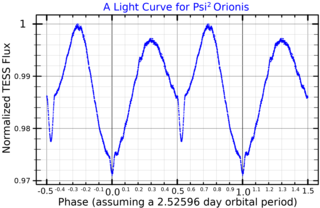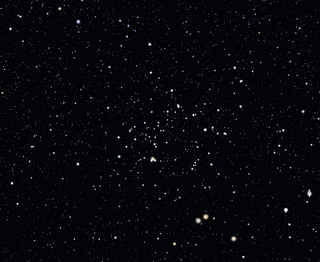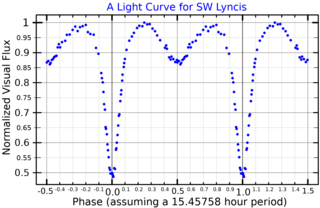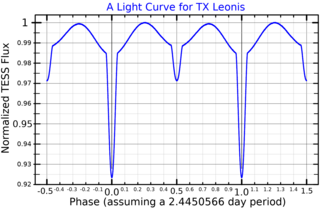
9 Andromedae, abbreviated 9 And by convention, is a variable binary star system in the northern constellation Andromeda. 9 Andromedae is the Flamsteed designation, while it bears the variable star designation AN Andromedae, or AN And. The maximum apparent visual magnitude of the system is 5.98, which places it near the lower limit of visibility to the human eye. Based upon an annual parallax shift of 7.1 mas, it is located 460 light years from the Earth.

31 Camelopardalis is a binary star system in the northern circumpolar constellation of Camelopardalis. It is visible to the naked eye as a dim point of light with a peak apparent visual magnitude of +5.12. Parallax measurements provide a distance estimate of approximately 460 light years away from the Sun, and the system is drifting closer to the Earth with a radial velocity of −3 km/s.
42 Cassiopeiae is a possible binary star system in the northern circumpolar constellation of Cassiopeia. It is visible to the naked eye as a dim, blue-white hued star with a baseline apparent visual magnitude of +5.18. The system is located approximately 291 light years from the Sun based on parallax, and is drifting further away with a radial velocity of +7 km/s.
ι Crucis, Latinized as Iota Crucis, is a wide double star in the southern constellation of Crux. It is visible to the naked eye as a faint, orange-hued point of light with an apparent visual magnitude of 4m.69. This object is located 125 light-years from the Sun, based on parallax, and is drifting further away with a radial velocity of +7.5 km/s.

32 Cygni is the Flamsteed designation for a binary star system in the Cygnus constellation. It is a 4th magnitude star, which can be seen with the naked eye under suitably dark skies. Parallax measurements give an estimated distance of 1,100 light-years (320 parsecs) from the Earth. However, Schröder et al. (2007) suggest the actual value, after correcting for Malmquist bias, may be closer to 1,174 light-years (360 parsecs). Although it is a spectrsocopic binary with components that cannot be separated visually, it has two entries in the Henry Draper Catalogue, with identical magnitudes and positions, but showing the spectral types of the two components.

DV Aquarii is a binary star system in the zodiac constellation of Aquarius. It has a peak apparent visual magnitude of 5.89, which is bright enough to be visible to the naked eye. The distance can be estimated from its annual parallax shift of 11.2 mas, yielding a separation of 291 light years.

68 Herculis is a triple star system located around 950 light-years away from the Sun in the northern constellation of Hercules. In the astronomical community it is often referred to by its Bayer designation of u Herculis, while 68 Herculis is the Flamsteed designation. The system is visible to the naked eye as a faint, blue-white-hued point of light with a peak apparent visual magnitude of 4.80. It is approaching the Earth with a heliocentric radial velocity of −17 km/s.
23 Orionis is a double star located around 1,200 light-years away from the Sun in the equatorial constellation of Orion. It is visible to the naked eye as a dim, blue-white-hued point of light with a combined apparent visual magnitude of 4.99. The pair are moving away from the Earth with a heliocentric radial velocity of +18 km/s, and they are members of the Orion OB1 association, subgroup 1a.

Psi2 Orionis a binary star system in the equatorial constellation of Orion. It has an apparent visual magnitude of 4.6, indicating that it is visible to the naked eye. Based upon an annual parallax shift of 2.87 mass, it is roughly 1,100 light years distant from the Sun.
74 Orionis is a single star in the equatorial constellation of Orion. It has the Bayer designation k Orionis, while 74 Orionis is the Flamsteed designation. This object is visible to the naked eye as a faint, yellow-white hued point of light with an apparent visual magnitude of 5.04. It is located at a distance of 64 light years from the Sun based on parallax, and is drifting further away with a radial velocity of +9 km/s. The star has a relatively high proper motion, traversing the celestial sphere at the rate of 0.204 arc seconds per annum.

HO Telescopii is an eclipsing binary star system located in the southern constellation of Telescopium. The maximum apparent visual magnitude of 8.22 is too faint to be visible to the naked eye. The system is located at a distance of approximately 910 light years based on parallax. The combined stellar classification of the system is A7III(m), matching an evolved A-type star that is possibly metallic-lined. The system is around 1.1 billion years old and consists of two stars of similar mass and size.

DS Andromedae is an eclipsing binary star in the constellation Andromeda and a member of the open cluster NGC 752. Its maximum apparent visual magnitude is 10.44, but drops down to 10.93 during the main eclipse and to 10.71 during the secondary one.

V752 Centauri is multiple star system and variable star in the constellation of Centaurus. An eclipsing binary, its apparent magnitude has a maximum of 9.10, dimming to 9.66 during primary eclipse and 9.61 during secondary eclipse. Its variability was discovered by Howard Bond in 1970. From parallax measurements by the Gaia spacecraft, the system is located at a distance of 410 light-years from Earth.

TX Ursae Majoris is an eclipsing binary star system in the northern circumpolar constellation of Ursa Major. With a combined apparent visual magnitude of 6.97, the system is too faint to be readily viewed with the naked eye. The pair orbit each other with a period of 3.063 days in a circular orbit, with their orbital plane aligned close to the line of sight from the Earth. During the primary eclipse, the net brightness decreases by 1.74 magnitudes, while the secondary eclipse results in a drop of just 0.07 magnitude. TX UMa is located at a distance of approximately 780 light years from the Sun based on parallax measurements, but is drifting closer with a mean radial velocity of −13 km/s.

BH Virginis is a binary star system in the equatorial constellation of Virgo. With a typical apparent visual magnitude of 9.6, it is too faint to be visible to the naked eye. Based on parallax measurements, it is located at a distance of approximately 488 light years from the Sun. The system is drifting closer with a net radial velocity of −23 km/s.

HU Tauri is a tight binary star system in the equatorial constellation of Taurus. It is an eclipsing binary, which means that the member stars periodically eclipse each other every 2.056 days. They have a combined apparent visual magnitude of 5.85, which is bright enough to be dimly visible to the naked eye. During the primary eclipse, the magnitude drops to 6.68, while the secondary eclipse decreases the magnitude to 5.91. The distance to this system, based on parallax measurements, is approximately 414 light years.

SW Lyncis is a binary or possibly a multiple-star system in the northern constellation of Lynx, abbreviated SW Lyn. With a combined apparent visual magnitude of 9.58, it is too faint to be visible to the naked eye. The system is located at a distance of approximately 970 light years based on parallax measurements, and is drifting further away with a net radial velocity of about +32 km/s.

VV Ursae Majoris is a binary star system in the northern circumpolar constellation of Ursa Major, abbreviated VV UMa. It is a variable star system with a brightness that cycles around an apparent visual magnitude of 10.19, making it too faint to be visible to the naked eye. The system is located at a distance of approximately 1,500 light years based on parallax measurements.

RS Sagittarii is an eclipsing binary star system in the southern constellation of Sagittarius, abbreviated RS Sgr. It is a double-lined spectroscopic binary with an orbital period of 2.416 days, indicating that the components are too close to each other to be individually resolved. The system has a combined apparent visual magnitude of 6.01, which is bright enough to be faintly visible to the naked eye. During the primary eclipse the brightness drops to magnitude 6.97, while the secondary eclipse is of magnitude 6.28. The distance to this system is approximately 1,420 light years based on parallax measurements.

TX Leonis, also known by its Flamsteed designation 49 Leonis, is a triple star system that includes an eclipsing binary, located in the constellation Leo. It was discovered to be a variable star, showing eclipses, by Ernst-Joachim Meyer in 1933. The apparent magnitude of TX Leonis ranges between 5.66 and 5.75, making it faintly visible to the naked eye for an observer located well outside of urban areas. The star's brightness drops by 0.09 and 0.03 magnitudes during the primary and secondary eclipses respectively, and neither the primary nor the secondary eclipse is total.
















